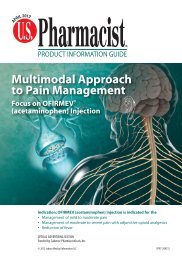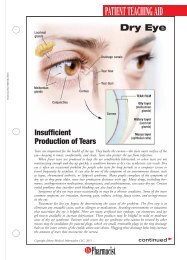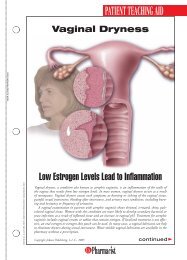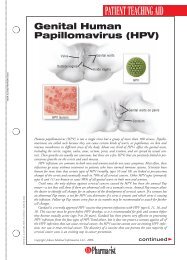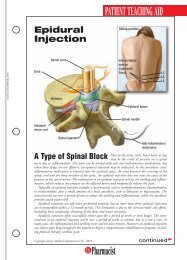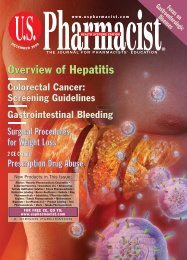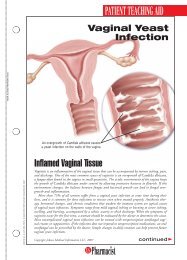View PDF Edition - U.S. Pharmacist
View PDF Edition - U.S. Pharmacist
View PDF Edition - U.S. Pharmacist
Create successful ePaper yourself
Turn your PDF publications into a flip-book with our unique Google optimized e-Paper software.
ONGLYZA (saxagliptin) tabletsBrief Summary of Prescribing Information. For complete prescribinginformation consult official package insert.INDICATIONS AND USAGEMonotherapy and Combination TherapyONGLYZA (saxagliptin) is indicated as an adjunct to diet and exercise to improveglycemic control in adults with type 2 diabetes mellitus. [See Clinical Studies(14).]Important Limitations of UseONGLYZA should not be used for the treatment of type 1 diabetes mellitus ordiabetic ketoacidosis, as it would not be effective in these settings.ONGLYZA has not been studied in combination with insulin.CONTRAINDICATIONSNone.WARNINGS AND PRECAUTIONSUse with Medications Known to Cause HypoglycemiaInsulin secretagogues, such as sulfonylureas, cause hypoglycemia. Therefore,a lower dose of the insulin secretagogue may be required to reduce the riskof hypoglycemia when used in combination with ONGLYZA. [See AdverseReactions (6.1).]Macrovascular OutcomesThere have been no clinical studies establishing conclusive evidence ofmacrovascular risk reduction with ONGLYZA or any other antidiabetic drug.ADVERSE REACTIONSClinical Trials ExperienceBecause clinical trials are conducted under widely varying conditions, adversereaction rates observed in the clinical trials of a drug cannot be directlycompared to rates in the clinical trials of another drug and may not reflect therates observed in practice.Monotherapy and Add-On Combination TherapyIn two placebo-controlled monotherapy trials of 24-weeks duration, patientswere treated with ONGLYZA 2.5 mg daily, ONGLYZA 5 mg daily, and placebo.Three 24-week, placebo-controlled, add-on combination therapy trials werealso conducted: one with metformin, one with a thiazolidinedione (pioglitazoneor rosiglitazone), and one with glyburide. In these three trials, patients wererandomized to add-on therapy with ONGLYZA 2.5 mg daily, ONGLYZA 5 mgdaily, or placebo. A saxagliptin 10 mg treatment arm was included in one ofthe monotherapy trials and in the add-on combination trial with metformin.In a prespecified pooled analysis of the 24-week data (regardless of glycemicrescue) from the two monotherapy trials, the add-on to metformin trial, theadd-on to thiazolidinedione (TZD) trial, and the add-on to glyburide trial, theoverall incidence of adverse events in patients treated with ONGLYZA 2.5 mgand ONGLYZA 5 mg was similar to placebo (72.0% and 72.2% versus 70.6%,respectively). Discontinuation of therapy due to adverse events occurred in2.2%, 3.3%, and 1.8% of patients receiving ONGLYZA 2.5 mg, ONGLYZA 5 mg,and placebo, respectively. The most common adverse events (reported in atleast 2 patients treated with ONGLYZA 2.5 mg or at least 2 patients treatedwith ONGLYZA 5 mg) associated with premature discontinuation of therapyincluded lymphopenia (0.1% and 0.5% versus 0%, respectively), rash (0.2%and 0.3% versus 0.3%), blood creatinine increased (0.3% and 0% versus 0%),and blood creatine phosphokinase increased (0.1% and 0.2% versus 0%). Theadverse reactions in this pooled analysis reported (regardless of investigatorassessment of causality) in ≥5% of patients treated with ONGLYZA 5 mg, andmore commonly than in patients treated with placebo are shown in Table 1.Table 1: Adverse Reactions (Regardless of Investigator Assessmentof Causality) in Placebo-Controlled Trials* Reported in 5%of Patients Treated with ONGLYZA 5 mg and MoreCommonly than in Patients Treated with PlaceboNumber (%) of PatientsONGLYZA 5 mg PlaceboN=882 N=799Upper respiratory tract infection 68 (7.7) 61 (7.6)Urinary tract infection 60 (6.8) 49 (6.1)Headache 57 (6.5) 47 (5.9)* The 5 placebo-controlled trials include two monotherapy trials and oneadd-on combination therapy trial with each of the following: metformin,thiazolidinedione, or glyburide. Table shows 24-week data regardless ofglycemic rescue.In patients treated with ONGLYZA 2.5 mg, headache (6.5%) was the onlyadverse reaction reported at a rate ≥5% and more commonly than in patientstreated with placebo.In this pooled analysis, adverse reactions that were reported in ≥2% of patientstreated with ONGLYZA 2.5 mg or ONGLYZA 5 mg and ≥1% more frequentlycompared to placebo included: sinusitis (2.9% and 2.6% versus 1.6%,respectively), abdominal pain (2.4% and 1.7% versus 0.5%), gastroenteritis(1.9% and 2.3% versus 0.9%), and vomiting (2.2% and 2.3% versus 1.3%).In the add-on to TZD trial, the incidence of peripheral edema was higher forONGLYZA 5 mg versus placebo (8.1% and 4.3%, respectively). The incidenceof peripheral edema for ONGLYZA 2.5 mg was 3.1%. None of the reportedadverse reactions of peripheral edema resulted in study drug discontinuation.Rates of peripheral edema for ONGLYZA 2.5 mg and ONGLYZA 5 mg versusplacebo were 3.6% and 2% versus 3% given as monotherapy, 2.1% and 2.1%versus 2.2% given as add-on therapy to metformin, and 2.4% and 1.2% versus2.2% given as add-on therapy to glyburide.The incidence rate of fractures was 1.0 and 0.6 per 100 patient-years,respectively, for ONGLYZA (pooled analysis of 2.5 mg, 5 mg, and 10 mg) andplacebo. The incidence rate of fracture events in patients who receivedONGLYZA did not increase over time. Causality has not been established andnonclinical studies have not demonstrated adverse effects of saxagliptin onbone.An event of thrombocytopenia, consistent with a diagnosis of idiopathicthrombocytopenic purpura, was observed in the clinical program. Therelationship of this event to ONGLYZA is not known.Adverse Reactions Associated with ONGLYZA (saxagliptin)Coad ministered with Metformin in Treatment-Naive Patients withType 2 DiabetesTable 2 shows the adverse reactions reported (regardless of investigatorassessment of causality) in ≥5% of patients participating in an additional24-week, active-controlled trial of coadministered ONGLYZA and metforminin treatment-naive patients.Table 2: Initial Therapy with Combination of ONGLYZA and Metforminin Treatment-Naive Patients: Adverse Reactions Reported(Regardless of Investigator Assessment of Causality) in 5%of Patients Treated with Combination Therapy of ONGLYZA5 mg Plus Metformin (and More Commonly than in PatientsTreated with Metformin Alone)Number (%) of PatientsONGLYZA 5 mg + Metformin* Metformin*N=320 N=328Headache 24 (7.5) 17 (5.2)Nasopharyngitis 22 (6.9) 13 (4.0)* Metformin was initiated at a starting dose of 500 mg daily and titrated upto a maximum of 2000 mg daily.HypoglycemiaAdverse reactions of hypoglycemia were based on all reports of hypoglycemia;a concurrent glucose measurement was not required. In the add-on toglyburide study, the overall incidence of reported hypoglycemia was higher forONGLYZA 2.5 mg and ONGLYZA 5 mg (13.3% and 14.6%) versus placebo(10.1%). The incidence of confirmed hypoglycemia in this study, defined assymptoms of hypoglycemia accompanied by a fingerstick glucose value of≤50 mg/dL, was 2.4% and 0.8% for ONGLYZA 2.5 mg and ONGLYZA 5 mg and0.7% for placebo. The incidence of reported hypoglycemia for ONGLYZA2.5 mg and ONGLYZA 5 mg versus placebo given as monotherapy was 4.0%and 5.6% versus 4.1%, respectively, 7.8% and 5.8% versus 5% given asadd-on therapy to metformin, and 4.1% and 2.7% versus 3.8% given asadd-on therapy to TZD. The incidence of reported hypoglycemia was 3.4% intreatment-naive patients given ONGLYZA 5 mg plus metformin and 4.0% inpatients given metformin alone.Hypersensitivity ReactionsHypersensitivity-related events, such as urticaria and facial edema in the5-study pooled analysis up to Week 24 were reported in 1.5%, 1.5%, and 0.4%of patients who received ONGLYZA 2.5 mg, ONGLYZA 5 mg, and placebo,respectively. None of these events in patients who received ONGLYZA requiredhospitalization or were reported as life-threatening by the investigators. Onesaxagliptin-treated patient in this pooled analysis discontinued due togeneralized urticaria and facial edema.Vital SignsNo clinically meaningful changes in vital signs have been observed in patientstreated with ONGLYZA.Laboratory TestsAbsolute Lymphocyte CountsThere was a dose-related mean decrease in absolute lymphocyte countobserved with ONGLYZA. From a baseline mean absolute lymphocyte count ofapproximately 2200 cells/microL, mean decreases of approximately 100 and120 cells/microL with ONGLYZA 5 mg and 10 mg, respectively, relative toplacebo were observed at 24 weeks in a pooled analysis of fiveplacebo-controlled clinical studies. Similar effects were observed whenONGLYZA 5 mg was given in initial combination with metformin compared tometformin alone. There was no difference observed for ONGLYZA 2.5 mgrelative to placebo. The proportion of patients who were reported to have alymphocyte count ≤750 cells/microL was 0.5%, 1.5%, 1.4%, and 0.4% in thesaxagliptin 2.5 mg, 5 mg, 10 mg, and placebo groups, respectively. In mostpatients, recurrence was not observed with repeated exposure to ONGLYZAalthough some patients had recurrent decreases upon rechallenge that led todiscontinuation of ONGLYZA. The decreases in lymphocyte count were notassociated with clinically relevant adverse reactions.The clinical significance of this decrease in lymphocyte count relative toplacebo is not known. When clinically indicated, such as in settings of unusualor prolonged infection, lymphocyte count should be measured. The effect ofONGLYZA on lymphocyte counts in patients with lymphocyte abnormalities(e.g., human immunodeficiency virus) is unknown.PlateletsONGLYZA did not demonstrate a clinically meaningful or consistent effect onplatelet count in the six, double-blind, controlled clinical safety and efficacytrials.DRUG INTERACTIONSInducers of CYP3A4/5 EnzymesRifampin significantly decreased saxagliptin exposure with no change in thearea under the time-concentration curve (AUC) of its active metabolite,5-hydroxy saxagliptin. The plasma dipeptidyl peptidase-4 (DPP4) activityinhibition over a 24-hour dose interval was not affected by rifampin. Therefore,dosage adjustment of ONGLYZA is not recommended. [See ClinicalPharmacology (12.3).]Inhibitors of CYP3A4/5 EnzymesModerate Inhibitors of CYP3A4/5Diltiazem increased the exposure of saxagliptin. Similar increases in plasmaconcentrations of saxagliptin are anticipated in the presence of other moderateCYP3A4/5 inhibitors (e.g., amprenavir, aprepitant, erythromycin, fluconazole,fosamprenavir, grapefruit juice, and verapamil); however, dosage adjustmentof ONGLYZA is not recommended. [See Clinical Pharmacology (12.3).]Strong Inhibitors of CYP3A4/5Ketoconazole significantly increased saxagliptin exposure. Similar significantincreases in plasma concentrations of saxagliptin are anticipated with otherstrong CYP3A4/5 inhibitors (e.g., atazanavir, clarithromycin, indinavir,itraconazole, nefazodone, nelfinavir, ritonavir, saquinavir, and telithromycin).The dose of ONGLYZA should be limited to 2.5 mg when coadministered witha strong CYP3A4/5 inhibitor. [See Dosage and Administration (2.3) and ClinicalPharmacology (12.3).]USE IN SPECIFIC POPULATIONSPregnancyPregnancy Category BThere are no adequate and well-controlled studies in pregnant women.Because animal reproduction studies are not always predictive of humanresponse, ONGLYZA (saxagliptin), like other antidiabetic medications, shouldbe used during pregnancy only if clearly needed.Saxagliptin was not teratogenic at any dose tested when administered topregnant rats and rabbits during periods of organogenesis. Incompleteossification of the pelvis, a form of developmental delay, occurred in rats at adose of 240 mg/kg, or approximately 1503 and 66 times human exposure tosaxagliptin and the active metabolite, respectively, at the maximumrecommended human dose (MRHD) of 5 mg. Maternal toxicity and reducedfetal body weights were observed at 7986 and 328 times the human exposureat the MRHD for saxagliptin and the active metabolite, respectively. Minorskeletal variations in rabbits occurred at a maternally toxic dose of 200 mg/kg,or approximately 1432 and 992 times the MRHD. When administered to ratsin combination with metformin, saxagliptin was not teratogenic norembryolethal at exposures 21 times the saxagliptin MRHD. Combinationadministration of metformin with a higher dose of saxagliptin (109 times thesaxagliptin MRHD) was associated with craniorachischisis (a rare neural tubedefect characterized by incomplete closure of the skull and spinal column) intwo fetuses from a single dam. Metformin exposures in each combination were4 times the human exposure of 2000 mg daily.Saxagliptin administered to female rats from gestation day 6 to lactation day20 resulted in decreased body weights in male and female offspring only atmaternally toxic doses (exposures ≥1629 and 53 times saxagliptin and itsactive metabolite at the MRHD). No functional or behavioral toxicity wasobserved in offspring of rats administered saxagliptin at any dose.Saxagliptin crosses the placenta into the fetus following dosing in pregnant rats.Nursing MothersSaxagliptin is secreted in the milk of lactating rats at approximately a 1:1 ratiowith plasma drug concentrations. It is not known whether saxagliptin issecreted in human milk. Because many drugs are secreted in human milk,caution should be exercised when ONGLYZA is administered to a nursingwoman.Pediatric UseSafety and effectiveness of ONGLYZA in pediatric patients have not beenestablished.Geriatric UseIn the six, double-blind, controlled clinical safety and efficacy trials of ONGLYZA,634 (15.3%) of the 4148 randomized patients were 65 years and over, and59 (1.4%) patients were 75 years and over. No overall differences in safety oreffectiveness were observed between patients ≥65 years old and the youngerpatients. While this clinical experience has not identified differences inresponses between the elderly and younger patients, greater sensitivity ofsome older individuals cannot be ruled out.Saxagliptin and its active metabolite are eliminated in part by the kidney.Because elderly patients are more likely to have decreased renal function, careshould be taken in dose selection in the elderly based on renal function. [SeeDosage and Administration (2.2) and Clinical Pharmacology (12.3).]OVERDOSAGEIn a controlled clinical trial, once-daily, orally-administered ONGLYZA in healthysubjects at doses up to 400 mg daily for 2 weeks (80 times the MRHD) had nodose-related clinical adverse reactions and no clinically meaningful effect onQTc interval or heart rate.In the event of an overdose, appropriate supportive treatment should beinitiated as dictated by the patient’s clinical status. Saxagliptin and its activemetabolite are removed by hemodialysis (23% of dose over 4 hours).PATIENT COUNSELING INFORMATIONSee FDA-approved patient labeling.InstructionsPatients should be informed of the potential risks and benefits of ONGLYZAand of alternative modes of therapy. Patients should also be informed aboutthe importance of adherence to dietary instructions, regular physical activity,periodic blood glucose monitoring and A1C testing, recognition andmanagement of hypoglycemia and hyperglycemia, and assessment of diabetescomplications. During periods of stress such as fever, trauma, infection, orsurgery, medication requirements may change and patients should be advisedto seek medical advice promptly.Physicians should instruct their patients to read the Patient Package Insertbefore starting ONGLYZA therapy and to reread it each time the prescriptionis renewed. Patients should be instructed to inform their doctor or pharmacistif they develop any unusual symptom or if any existing symptom persistsor worsens.Laboratory TestsPatients should be informed that response to all diabetic therapies shouldbe monitored by periodic measurements of blood glucose and A1C, with agoal of decreasing these levels toward the normal range. A1C is especiallyuseful for evaluating long-term glycemic control. Patients should be informedof the potential need to adjust their dose based on changes in renal functiontests over time.Manufactured by:Princeton, NJ 08543 USAMarketed by:Bristol-Myers Squibb CompanyPrinceton, NJ 08543andAstraZeneca Pharmaceuticals LPWilmington, DE 198501256316 1256317 SA-B0001A-07-09 Iss July 2009





